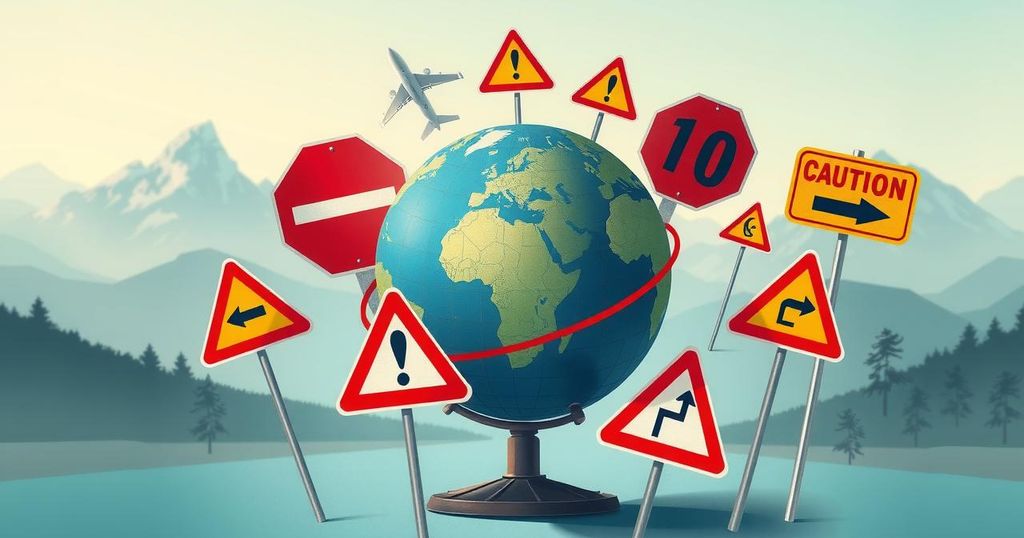U.S. Issues Cautionary Travel Advisory for 20 High-Risk Countries

The U.S. has issued a “Do Not Travel” advisory for 20 nations, citing serious safety risks. Classified as Level 4, the advisory includes countries like Ukraine, North Korea, and Venezuela. The advisory’s implications extend to tourism, affecting economic stability and travel insurance practices, while emphasizing the need for enhanced safety measures in international travel.
In a significant advisory, the U.S. government has designated 20 countries as “Do Not Travel” zones, primarily due to serious safety risks and potential threats to life. This advisory, classified at Level 4—the highest risk category—serves as a critical alert for American citizens, urging them to avoid traveling to these regions and to regularly consult updated Travel Advisories for essential safety information. Countries flagged include Russia, North Korea, Iran, Iraq, Ukraine, Afghanistan, Belarus, Syria, Lebanon, Libya, Somalia, Sudan, Venezuela, and Yemen.
The U.S. State Department’s warning highlights a variety of dangers including ongoing armed conflicts, political instability, terrorism, and considerable civil unrest in the mentioned countries. Regions such as Ukraine and Yemen are currently experiencing significant conflicts that pose serious risks to travelers. Areas like Somalia and Libya are grappling with extremist threats, while nations such as Belarus and Venezuela are undergoing political crises, further complicating safety for international visitors.
The advisory has far-reaching implications for the travel and tourism industries. Countries that rely heavily on tourism, particularly Venezuela and Lebanon, may experience economic setbacks as international arrivals dwindle. Travelers are likely to adjust their itineraries to safer locales, influencing airlines, tour operators, and local hospitality sectors. Additionally, revisions to travel insurance policies may occur, with potential premium increases for these high-risk destinations.
To navigate the complexities of global travel in these uncertain times, travelers are urged to consider key factors before making travel arrangements. It is recommended that individuals consult the U.S. State Department’s Travel Advisory page for the latest safety updates, ensure their travel insurance comprises adequate coverage for cancellations and emergencies, and adhere to government warnings against non-essential travel to classified Level 4 regions.
For travel companies and tourism authorities, implementing strategies adapted to this evolving landscape is crucial. Emphasizing safer destinations with favorable safety records, offering flexible booking policies, and utilizing technology for real-time updates are vital. Providing resources that inform travelers about safety and emergency preparedness is also critical in this changing atmosphere.
The U.S. “Do Not Travel” advisory highlights a broader trend of increased global risks due to geopolitical tensions, environmental disruptions, and public health issues. As international travel resumes following the pandemic, safety remains a paramount concern for both authorities and travelers alike.
The issuance of the U.S. Department of State’s “Do Not Travel” advisory indicates growing global instability that necessitates increased caution for international travelers. This advisory categorizes more than a dozen countries as high-risk zones, reflecting significant concerns about safety due to political unrest, ongoing conflicts, and terrorism. Understanding these geopolitical risks is essential for travelers, as they navigate their options in a complex international landscape.
The U.S. “Do Not Travel” advisory highlights the ongoing challenges faced by international travelers in an increasingly unpredictable world. For tourists, it serves as a vital reminder to prioritize safety and make informed decisions regarding their travel plans. For the travel industry, it stresses the necessity for resilience and adaptability in response to evolving global scenarios. Collaboration between governments, travel businesses, and international organizations will be critical in fostering a safer travel environment as the industry continues to recover.
Original Source: www.travelandtourworld.com








